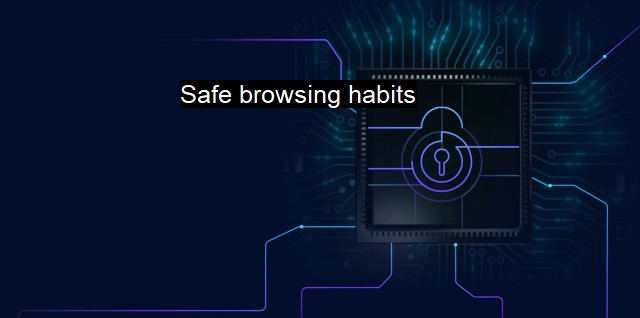What are Safe browsing habits?
Safeguard Your Online Presence: The Significance of Safe Browsing Habits and Antivirus Software in Cybersecurity
Safe browsing habits refer to the various steps and measures taken by internet users to maintain their security and safety while accessing and exploring various online platforms. This practice shields and protects users from issues such as cyber-attacks, identity theft, phishing schemes and scams, as well as accidental exposure to inappropriate content.In the present digital age, as online activities have become a fundamental part of our lives, there is an increased need for safe browsing habits. With immeasurable amounts of confidential and personal information being stored and shared online, such tasks as banking activities, sending vital emails or even posting images on social media have increased potential risks toward user data and privacy. These vulnerabilities often leave open opportunities for cybercriminals to exploit any possible loopholes.
Maintaining safe browsing habits involves various steps that can help keep your cybersecurity intact and your valuable data safe from cyber threats and malicious software. The first is installing and regularly updating antivirus software. This software ensures your computer, laptop, or mobile device is protected from becoming a target of unwanted activities and cyber threats, including viruses, worms, Trojan horses, or ransomware. Updating your software and operating systems regularly helps ward off potential attacks by sealing vulnerabilities that newer threats may try to exploit.
Another vital factor enforcing the practice of safe browsing habits includes being on the lookout for phishing emails, spam, and online scams. Phishing emails often masquerade as legitimate emails from reputable sources in an attempt to trick unsuspecting users into revealing sensitive information so as to exploit it. Hence, users should be cautious about opening mails from unknown or unreliable sources and never divulge sensitive information like passwords, banking details, PINs, etc. Reviewing websites, before opening, could help discern whether the site is secure and trustworthy or a potential trap by determining if it has an 'HTTPS' instead of 'HTTP' in its URL. Secure sites, with 'HTTPS', encrypt your data making it inaccessible to third-parties.
Another significant measure to practice for safe browsing involves strengthening passwords. Weak passwords are a straightforward route for hackers and cybercriminals causing breaches. Strong passwords, on the other hand, are more challenging to crack, offering an effective line of defense against unauthorized access to sensitive information. Use of password-generating and management tools is prudent as it approach uses algorithms to create passwords that are hard to crack. Users should also use unique passwords for every site, especially ones that encrypt sensitive data like bank and credit card information.
Actualizing the act of safe browsing also includes public Wi-Fi networks; they are notorious for being unsecure and susceptible to hacking. These public platforms often don't have secure encryption, making your device and confidential information vulnerable to cyber attacks. So it's prudent to avoid accessing sensitive information or making transactions when using public networks.
Understanding and routinely practicing safe browsing habits is not only about safeguarding own data, but also about cultivating a safer internet browsing space for everyone. With numerous cyber threats lurking around in the dark corners of the internet, treating every click and every webpage with caution could mean the difference between secure browsing and succumbing to cyber threats. Infusing these habits within day-to-day online behavior is likely to result in digitally safer surroundings, promoting better protection against the onslaught of ever-evolving cybersecurity threats.

Safe browsing habits FAQs
What are some safe browsing habits I should adopt to protect my computer against cyber threats?
To protect your computer against cyber threats, you should: 1. Use a reputable anti-virus software and keep it up-to-date 2. Be cautious when downloading files or opening email attachments 3. Use strong and unique passwords for your online accounts 4. Avoid clicking on suspicious links or pop-ups 5. Keep your operating system and software updated with the latest security patches.How can I protect my personal information when browsing online?
You can protect your personal information when browsing online by: 1. Avoiding public Wi-Fi networks 2. Using a virtual private network (VPN) when accessing sensitive information 3. Being selective about the websites you visit and the information you provide 4. Disabling location tracking on your browser 5. Clearing your browsing history and cache regularly.What are some signs that my computer may have been infected with malware?
Some signs that your computer may have been infected with malware include: 1. Slow performance and crashes 2. Pop-up ads and unwanted toolbars 3. Changes to your homepage or search engine settings 4. Unexpected programs running in the background 5. Unexplained data usage or network activity 6. Security alerts from your anti-virus software.How can I stay safe while shopping online?
To stay safe while shopping online, you should: 1. Only shop on reputable websites with secure connections 2. Use a credit card instead of a debit card 3. Avoid making purchases on public Wi-Fi networks 4. Check that the website's URL starts with "https" and has a padlock icon in the address bar 5. Keep your anti-virus software and operating system up-to-date 6. Monitor your bank and credit card statements for any suspicious transactions.| | A | | | B | | | C | | | D | | | E | | | F | | | G | | | H | | | I | | | J | | | K | | | L | | | M | |
| | N | | | O | | | P | | | Q | | | R | | | S | | | T | | | U | | | V | | | W | | | X | | | Y | | | Z | |
| | 1 | | | 2 | | | 3 | | | 4 | | | 7 | | | 8 | | |||||||